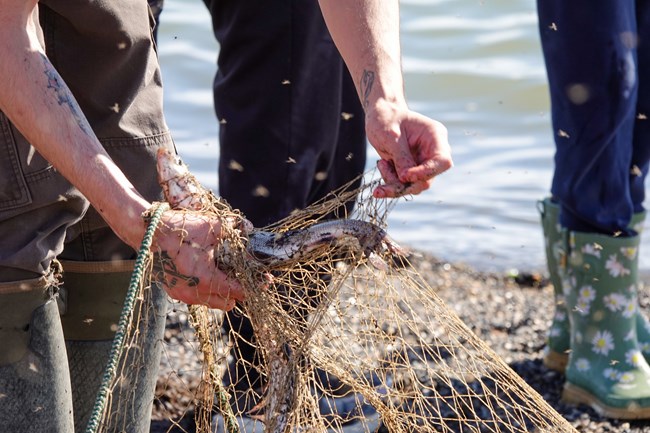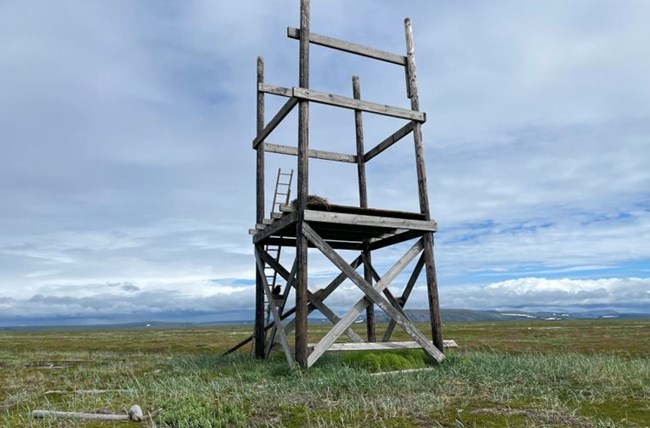
NPS Photo
Bordered by the Chukchi Sea to the west, Kotzebue Sound to the south, and the Noatak River to the east, Cape Krusenstern National Monument (Cape Krusenstern) feels like a window into the past. While wooly mammoths only exist in the fossil record, musk oxen still claim their place among the sweeping valleys and thick carpets of tundra. Beach ridges, formed by the slow accretion of sediment along the coast, bear the evidence of over 4,000 years of human occupation, which continues with subsistence users of the present. Subject to the extremes of the arctic weather, life in the monument requires specialized skills and adaptations as cold winds howl through the darkness of winter and ice chokes the coast. Exposed as it is to the constant battering of the wind and sea, Cape Krusenstern is nonetheless a haven for plants and wildlife that have learned to thrive during the vibrant summers. Migratory birds and waterfowl take advantage of protected coastal lagoons to feed and raise young. Small, hardy alpine plants bloom in a rainbow of colors along the Igichuk and Mulgrave Hills, and a wealth of berries emerge as caribou migrate from summer feeding grounds to fall breeding grounds. The connection with the sea is not far away: populations of fish and marine mammals play an important link in the ecosystem. Cape Krusenstern contains almost 597,000 acres of eligible wilderness, managed in accordance with NPS policy to preserve its wilderness character. While it is west of the larger designated wilderness areas of the Noatak National Preserve, Kobuk Valley National Park, Gates of the Arctic National Park & Preserve, and Selawik National Wildlife Refuge, it is an island unto itself with a unique set of threats and management challenges. All of Alaska’s NPS wilderness was designated in 1980 by the Alaska National Interest Lands Conservation Act, which created a more human-centric lens for wilderness stewardship than that which is found outside the state. However, the NPS’s primary mandate is the same across all federal lands: to preserve wilderness character. The holistic concept of wilderness character protects the biophysical environment, personal experiences, and symbolic meanings that collectively distinguish wilderness from general backcountry and frontcountry areas. Unique social, cultural, and ecological benefits of wilderness are rooted in wilderness character preservation. 
NPS Photo / Emily Creek Homeland as WildernessIñupiaq have inhabited and used this living cultural landscape for generations, as evidenced by both the archeological record and oral history. The continued subsistence use of both marine and terrestrial resources is an important component, and a founding purpose of the monument. Subsistence serves not only as an economic support but also as a cultural and social focus of the local residents. Land and resource uses are directly tied to cultural history, spiritual beliefs, sharing patterns, status, and value system. Participation in, even if peripheral, and identification with subsistence pursuits are unifying forces in the local culture. Without subsistence, the relevance of many customs and traditions would be diminished.The Iñupiat Ilitqusiat – that which makes us who we are – defines values of humility, respect for nature, and cooperation; values which live on in this landscape as the law of the land. Here, wilderness helps bridge the values and land ethics of Indigenous peoples and rural residents and those of people from around the world. Learn more about how subsistence is practiced today, as well as in the past through the Respect the Land (Kamaksrił̣iq Nunam Irrusianik) video. 
NPS Photo / Emily Creek Visiting Cape Krusenstern’s WildernessThe majority of Cape Krusenstern is undeveloped. Unlike most national parks, there are no roads, facilities, trails, or campgrounds, but it does offer outstanding opportunities to experience a genuine wilderness on its own terms.Please visit our list of licensed operators for trip facilitation, such as air taxi, guided rafting, or hunting: Licensed operators in Cape Krusenstern National Monument. |
Last updated: April 10, 2024
